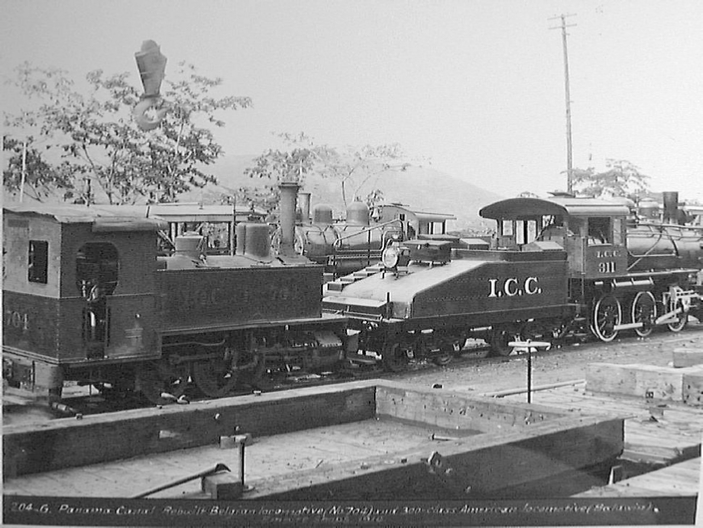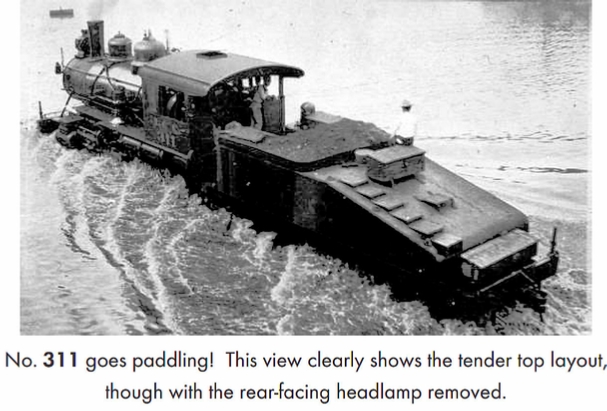

|
Principle Dimensions |
|
|
Class |
301- |
|
Locobase ID |
12183 |
|
Railroad |
Isthmian Canal Commission/Panama |
|
Country |
USA |
|
Whyte |
36562 |
|
Number in Class |
40 |
|
Road Numbers |
301- |
|
Gauge |
5' |
|
Number Built |
40 |
|
Builder |
Burnham, Williams & Co |
|
Year |
1907 |
|
Valve Gear |
Stephenson |
|
Locomotive Length and Weight |
|
|
Driver Wheelbase |
13 / 3.96 |
|
Engine Wheelbase |
20.50 / 6.25 |
|
Ratio of driving wheelbase to overall engine wheelbase |
0.63 |
|
Overall Wheelbase (engine & tender) |
57.29 / 17.46 |
|
Axle Loading (Maximum Weight per Axle) (lbs / kg) |
|
|
Weight on Drivers |
108,000 / 48,988 |
|
Engine Weight |
126,000 / 57,153 |
|
Tender Loaded Weight (lbs / kg) |
70000 |
|
Total Engine and Tender Weight |
196000 |
|
Tender Water Capacity (gals / ML) |
4000 / 15.15 |
|
Tender Fuel Capacity (oil/coal) |
|
|
Minimum weight of rail (calculated) |
60/1 |
|
Geometry Relating to Tractive Effort |
|
|
Driver Diameter |
54/1 |
|
Boiler Pressure |
180 |
|
High Pressure Cylinders (dia x stroke) (in / mm) |
19" x 24" / 483x610 |
|
Tractive Effort |
24,548 / 11134.80 |
|
Factor of Adhesion (Weight on Drivers / Tractive Effort) |
4.4 |
|
Heating Ability |
|
|
Tubes (number - |
252 - |
|
Flues (number - |
? |
|
Flue/Tube length |
11 / 3.35 |
|
Firebox Area |
151 / 14.03 |
|
Grate Area |
23.20 / 2.16 |
|
Evaporative Heating Surface (sq ft / m2) |
1590 / 147.77 |
|
Superheating Surface (sq ft / m2) |
? |
|
Combined Heating Surface (sq ft / m2) |
1590 / 147.77 |
|
Evaporative Heating Surface/Cylinder Volume |
201.78 |
|
Power Output |
|
|
Robert LeMassena's Power Computation |
4176/1 |
|
Same as above plus superheater percentage |
4176 |
|
Same as above but substitute firebox area for grate area |
27180 |
|
Power L1 |
4821 |
|
Power MT |
295.24 |
|
Factor of Adhesion (Weight on Drivers / Tractive Effort) |
4.91 |


| Guns & Cannon |
| Howitzers |
| Mortars |
| Flak |
| Cannon Wagons |
| ICBM |
| Locomotives |
| Rolling Stock |
| Armored Trains |
| Draisine |
| Narrow Guage |
| Locomotives |
| Rolling Stock |
| Armoured Trains |
| Draisine, Trolley, Handcar, Armored Railcars |
| Armored Platforms & Gun Cars |
| Locomotives |
| Rolling Stock |
| Mexican–American War (1846-1848) |
| American Civil War (1861–1865) |
| Spanish–American War (1898) |
| World War I (1914–1918) |
| Russian Civil War (1917–1923) |
| World War II (1939–1945) |
| Locomotives |
| Armoured Trains |
| Locomotives |
| USATC S100 Class (0-6-0T Tank ‘Switcher’) |
| USATC S160 Class, 2-8-0 Consolidation Type Steam Locomotive |
| USATC S200 Class, 2-8-2 Mikado Type Steam Locomotive |
| The 14-inch Railway Gun and Carriage Explained |
| How To Identify U.S. 14-Inch Railway Guns |
| How To Identify U.S. 12-Inch Railway Guns |
| Guide List of Major Railway Gun Mounting Systems (U.S. Civil War – WWII) |
| Steam Locomotive Tender Designs |